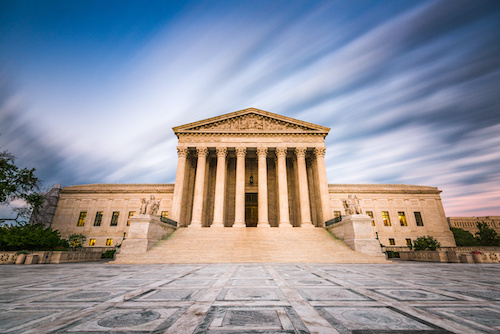Courts Got it Wrong in Interactive Wearables, Right in Tropp—But Both Petitions Should be Granted
“Applying modified versions of other doctrines in the guise of a Section 101 analysis unmoors those doctrines from the statutory text and diminishes their analytical rigor.” – Solicitor General’s brief
On Wednesday, April 5, the United States Solicitor General (SG) recommended that the U.S. Supreme Court grant certiorari in two patent eligibility cases in order to “clarify the proper reach and application of the abstract-idea exception to patent eligibility under Section 101.” The SG filed the same brief in each of the two cases, Interactive Wearables, LLC v. Polar Electric Oy and David A. Tropp v. Travel Sentry, Inc. et. al.
In Interactive Wearables, the U.S. Court of Appeals for the Federal Circuit (CAFC) summarily affirmed a district court’s finding that the relevant claims for Interactive’s patent covering “improved devices for playing audio and visual media content, such as cellphones, radios, and wearable devices,” were directed to the abstract idea of “providing information in conjunction with media content, ‘applied to the context’ of content players.”
The district court said that the claims “merely apply the abstract idea behind consulting a TV Guide—i.e., ‘to obtain more information’ about a program while viewing it—to a content player, rather than ‘provide[] a technological improvement’ to the content player itself.”
The Federal Circuit issued an affirmance under Rule 36, without explanation, and denied Interactive’s petition for rehearing or rehearing en banc in December 2021.
In the Tropp case, the CAFC ruled in February 2022 that the district court was correct in holding all of the claims at issue patent ineligible because they “essentially describe the basic steps of using and marketing a dual-access lock for luggage inspection, a long-standing fundamental economic practice and method of organizing human activity.” The CAFC said that the claims were directed to an abstract idea and that its precedents have “consistently recognize[d] the abstract character of such practices and methods.” The district court also found that Tropp had identified “no inventive concept” in the claims and the CAFC agreed.
Narrowing the Question
Both Tropp and Interactive Wearables petitioned the High Court in 2022. The SG filed the same brief yesterday in response to invitations from the Court to weigh in on both cases, advising the Court to grant the petitions on the question as framed by the SG. The SG’s question is simply: “Whether the claimed invention is ineligible for patent protection under the abstract-idea exception to Section 101.”
The brief noted that if either or both petitions are granted, the Court should reformulate the question as presented by the SG in order to focus narrowly on the abstract-idea exception. “The Interactive petition in particular seeks to inject issues that are not profitably addressed at this stage, including whether ‘patent eligibility (at each step of the Court’s two-step framework) [is] a question of law for the court based on the scope of the claims or a question of fact for the jury based on the state of art at the time of the patent,” said the SG’s brief.
Tropp’s question as presented in its petition asks: “Whether the claims at issue in Tropp’s patents reciting physical rather than computer-processing steps are patent-eligible under 35 U.S.C. § 101, as interpreted in Alice Corporation Pty v. CLS Bank International, 573 U.S. 208 (2014).”
Interactive Wearables is asking the Court to consider three questions:
- What is the appropriate standard for determining whether a patent claim is “directed to” a patent-ineligible concept under step one of the Court’s two-step framework for determining whether an invention is eligible for patenting under 35 U.S.C. § 101?
- Is patent eligibility (at each step of the Court’s two-step framework) a question of law for the court based on the scope of the claims or a question of fact for the jury based on the state of art at the time of the patent?
- Is it proper to apply 35 U.S.C. § 112 considerations to determine whether a patent claims eligible subject matter under 35 U.S.C. § 101?
SG: Right or Wrong, We Need Clarity
The SG said that the district court incorrectly focused on “considerations of novelty, obviousness, and enablement” at step two of the Alice-Mayo test in the Interactive Wearables case, while the Federal Circuit “correctly held that nothing in the claimed method transforms it into a technological invention” in the Tropp case.
While considerations of novelty, obviousness and enablement “may sometimes overlap with the abstract-idea inquiry, they are the purview of different statutory provisions and perform different functions,” said the SG’s brief. It added:
“The district court’s analysis in this case reflected a legitimate concern that the Interactive patents may be invalid due to anticipation, obviousness, or inadequate enablement. But applying modified versions of other doctrines in the guise of a Section 101 analysis unmoors those doctrines from the statutory text and diminishes their analytical rigor.”
While the Federal Circuit got it right in Tropp, the SG said it would still be useful for the Court to grant both petitions and to brief and argue them separately, rather than consolidating them, in order to provide “much-needed clarification in this area.” The cases involve very different types of inventions, said the SG, and they give the Court an opportunity to set forth clear guidance for what kinds of inventions “fall on either side of the line.”
The SG noted that both the Federal Circuit and the U.S. Patent and Trademark Office have struggled in recent years to apply the Supreme Court’s Section 101 precedent consistently, and that the Federal Circuit in particular has muddled the process. “The Federal Circuit has repeatedly invoked the abstract-idea exception by describing technological inventions at a high level of generality, and it has repeatedly imported distinct patent-law doctrines into the abstract-idea analysis,” wrote the SG.
The brief also dismissed Travel Sentry’s arguments in its response to Tropp that Section 101 confusion lies almost entirely with software and life science patents, and that review isn’t necessary because Congress is considering legislation to clarify patent eligibility. The SG said:
“In applying Section 101 to the comparatively less complex inventions at issue in these cases, the Court can more readily draw on historical practice and precedent to clarify the governing principles, which can then be translated to other contexts. And while the Tropp respondents assert…that review is unwarranted because Congress is currently considering legislation that may amend Section 101, the cited bill….died in committee with the conclusion of the 117th Congress.”
Image rights acquired by AdobeStock
Eileen McDermott
Eileen McDermott is the Editor-in-Chief of IPWatchdog.com. Eileen is a veteran IP and legal journalist, and no stranger to the intellectual property world, having held editorial and managerial positions at […see more]







